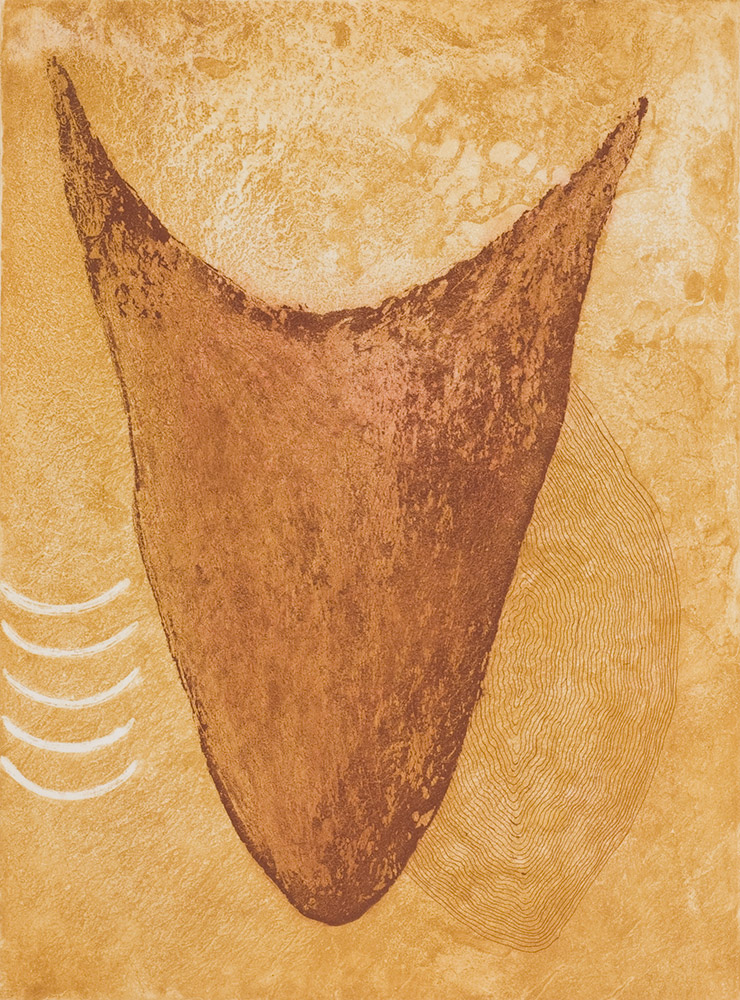We acknowledge the Traditional Owners of the land on which the Queensland Art Gallery | Gallery of Modern Art stands and recognise the creative contribution First Australians make to the art and culture of this country.

Judy Watson / Waanyi people / Australia b.1959 / head, heart, ribs 2000 / Etching on paper, ed. 39/40 / 48 x 35.6cm / Purchased 2003. The Queensland Government’s special Centenary Fund / Collection: Queensland Art Gallery | Gallery of Modern Art / © Judy Watson/Licensed by Viscopy, 2013
Judy Watsonhead, heart, ribs 2000
Not Currently on Display
In head, heart, ribs 2000, Judy Watson combines three distinct motifs which recur throughout her work, and which all reference the body and the land. Like many Indigenous artists, Watson’s work portrays a sense of the land from an aerial perspective, of which she says: ‘I try to paint the land from both above and beneath, to integrate the body with the country’.1
The central head/heart shape can be understood as a female form referring to various parts of the body — the heart, the lungs and the pubic region. As Watson explains, the form also references her ancestral homeland: ‘The head/heart shape is also like the gorge/female form of Lawn Hill Gorge in my grandmother’s country’.2
Endnotes:
1. Ben Holgate, ‘Beneath the earth’, Australian, 24 February 2001, p.2.
2. Judy Watson, artist statement, 2003, QAGOMA Research Library artist file.
Judy Watson was born in 1959 in Mundubbera, west of Maryborough, in south-east Queensland, and lives in Brisbane. The spirit and substance of her work can be found in the homeland of her grandmother and great-grandmother. A descendant of the Waanyi people of north-west Queensland, Watson completed a fine arts degree at the University of Tasmania in 1982.
While living in Sydney, Watson exhibited in the 1989 Artspace survey exhibition ‘A Koori Perspective’ and became associated with the Boomalli Aboriginal Artists Cooperative, which had been established to promote the work of urban Indigenous artists.
In 1995, she received the Moët & Chandon Australian Art Fellowship, and two years later was represented the country in the Australian Pavilion at the 47th Venice Biennale as part of ‘Fluent: Emily Kame Kngwarreye, Yvonne Koolmatrie, Judy Watson’. Watson’s work explores drawing, printmaking, painting and sculpture, all referencing an Indigenous connection to land and history.
Discussion Questions
How does the artist express the symbolic connection between her country and the body?
Classroom Activities
Using your imagination, draw your own body from the inside out. You may like to refer to some anatomical diagrams or a model of the human body for inspiration. On top of your ‘inside-out’ drawing, make another drawing using a different colour or medium. Try to develop the drawing so both layers have equal importance. What does your finished drawing say about you? You could also complete this task by scanning drawings and photographs and layering the images using Photoshop.